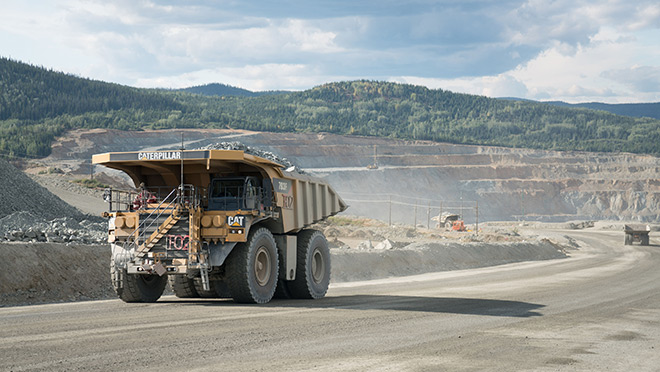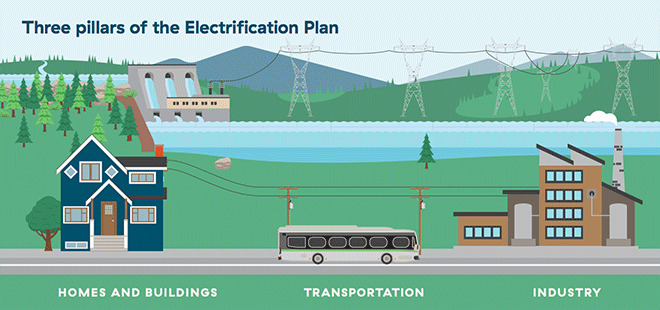Weaning industry off fossil fuels key to GHG reductions

Two B.C.-based mines switch some operations to clean electricity
Part two in a series on BC Hydro's Electrification Plan.
Bolstered by a new suite of programs and incentives, carbon-intensive industries in B.C. are starting to walk the talk on sustainability in ways that may have seemed almost laughingly improbable a few years ago.
The operation of everything from conveyors and chippers to haul trucks, boilers, and pumps is now open to reinvention. And suddenly, a copper mine has gone public in setting a net zero GHG target for 2035.
"Through hydro electrification and capacity increases, we plan to reduce our carbon intensity by over 50% in five to seven years as we aim to be net zero by 2035," said Gil Clausen, president and CEO of the Princeton-area Copper Mountain Mine, back in December of 2020. "So not only will Copper Mountain be producing the metals that drive a green economy, we will deliver that value the right way."
This spring, Copper Mountain takes its first step on the road to net zero when it starts operation of a one-kilometre section of electric trolleys designed to help 11 full-size hybrid Komatsu trucks haul ore uphill from the main mining pit to the operation's primary crusher. The company estimates savings of 400 litres of diesel per hour per truck.
The trolley-assist operation is the first of its kind in North America, but it's not alone in B.C. in moving away from diesel. An 11-hour drive north of Copper Mountain, and more than three hours north of Prince George, the Mount Milligan Mine has hooked up to BC Hydro electricity to power groundwater wells in place of diesel. BC Hydro paid for a consultant to complete a low-carbon electrification study at the mine. And with no distribution line nearby, the company leaned on incentives to help install a 3.5-kilometre 25 kilovolt (kV) overhead distribution line to bring electricity to the pumping system.
Electrification of the water pumping system for the copper and gold mine will save the company about a million dollars a year while trimming about 23,000 tonnes of carbon dioxide equivalent emissions through to 2028.
These are two examples of how B.C. is increasingly powered by water. Using clean and renewable hydroelectric power to shift B.C. homes, businesses and industry away from fossil fuels is a major plank in the Government of BC's ambitious climate action plan. And industrial operations alone account for 40% of B.C.'s greenhouse gas emissions.
BC Hydro's Electrification Plan is expected to result in GHG reductions of 930,000 tonnes per year by 2026, the equivalent of taking about 200,000 cars off the road.
Energy studies now look beyond energy savings to GHG emissions
Energy efficiency and the savings they bring are still central to BC Hydro programs, but when studying or auditing a facility or process, there's now a keen eye on the potential for fuel-switching in the name of GHG reductions.
"In the past we've been more focussed on the conservation side," says Tamara Berger, marketing manager for BC Hydro's industrial group. "Now we're more formally wholistic about things. We're building in fuel-switching as a portion of our plant-wide audits. If we see something in an audit that might apply to low-carbon electrification, we want it to be included as an opportunity to be looked at further by the customer. And we can also stream them over to the LCE feasibility study funding as a next step."
The key for many operations is "stacking" of funding, with CleanBC funding often taking the lead as the primary driver of GHG savings.
How we reach more customers with offers
Berger says that while many large customers are well-served by key account managers and, in some cases, on-site energy managers, there's great potential to reach customers who have had little if anything to do with BC Hydro incentives in the past.
That includes oil and gas industry customers whose interest in electrifying operations has grown with the addition of lucrative CleanBC incentives. But it's the small to medium customers – including those in the food and beverage industry – who have been most difficult to reach.
"For smaller customers, I'd say we haven't had as many applications for low-carbon electrification, at least not yet," says Berger. "It's a matter of getting the word out there, and it can be harder to estimate which projects will be eligible for incentives. Sometimes a small project will make sense, too, because it has high demand, for example."
Learn more about BC Hydro's Electrification Plan
The role of carbon taxes, and rates incentives
The CleanBC Program for Industry directs a portion of the carbon taxes paid by industry into two CleanBC initiatives that work together to support cleaner industry, reduce emissions and increase technological innovation. The Government of BC also offers carbon offsets and royalty deductions for greenhouse gas emissions reduction projects.
BC Hydro offers both rates and capital incentives to encourage electrification among industrial customers. CleanBC's Industrial Electrification Rates—Fuel Switching, introduced in 2021, offers a discount to BC Hydro's standard transmission service rate for a period of seven years. The rate is designed to encourage existing and new industrial customers to electrify their operations by connecting into BC Hydro's grid instead of relying on fossil fuels.
On the capital side, the CleanBC Facilities Electrification Fund helps reduce the cost to connect to BC Hydro's clean electricity grid. Customers with greenhouse gas reduction projects can receive up to 50 per cent of their interconnection cost to a maximum of $15 million.
How the Mount Milligan Mine tapped into clean electricity
Mount Milligan Mine requires use of permitted freshwater to maintain mill operations, and it sources it both from surface water withdrawals from Philips Lake and Rainbow Creek, as well as from three groundwater wells in the Lower Rainbow Valley. But that well field was being powered by a pair of 500kW diesel-fired generators, because BC Hydro distribution power lines sat 3.5 km away.
In early 2020, with a financial commitment from BC Hydro's Low Carbon Electrification Incentive Fund, Mount Milligan constructed the 3.5km extension of the 25kV electrical distribution network. With clean and reliable electricity available to operate the well pumps, Mount Milligan removed the diesel generators at the Lower Rainbow Valley.
The switch paid off within a year, as Mount Milligan is saving more than a million dollars a year in operating costs. And the CO2 emissions reductions through 2028 add up to the equivalent of taking more than 7,000 passenger vehicles off B.C. roads for a year.
Related:

